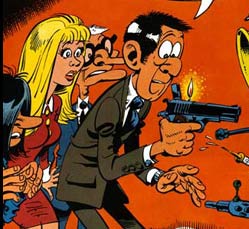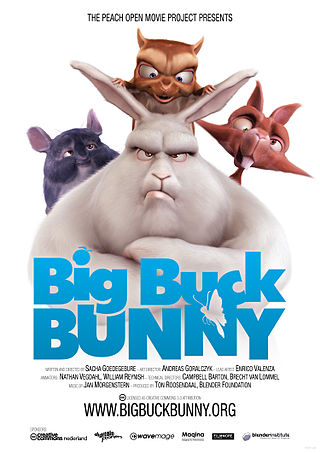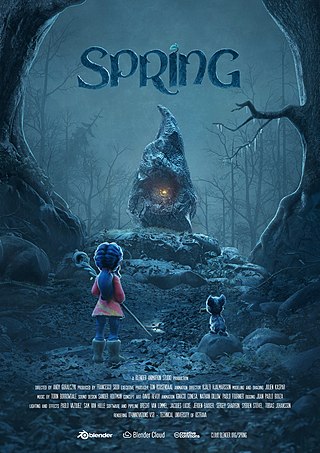
Blender is a free and open-source 3D computer graphics software tool set used for creating animated films, visual effects, art, 3D-printed models, motion graphics, interactive 3D applications, virtual reality, and, formerly, video games. Blender's features include 3D modelling, UV mapping, texturing, digital drawing, raster graphics editing, rigging and skinning, fluid and smoke simulation, particle simulation, soft body simulation, sculpting, animation, match moving, rendering, motion graphics, video editing, and compositing.
A mango is an edible stone fruit produced by the tropical tree Mangifera indica.

In computing, a visual programming language or block coding is a programming language that lets users create programs by manipulating program elements graphically rather than by specifying them textually. A VPL allows programming with visual expressions, spatial arrangements of text and graphic symbols, used either as elements of syntax or secondary notation. For example, many VPLs are based on the idea of "boxes and arrows", where boxes or other screen objects are treated as entities, connected by arrows, lines or arcs which represent relations.
COLLADA is an interchange file format for interactive 3D applications. It is managed by the nonprofit technology consortium, the Khronos Group, and has been adopted by ISO as a publicly available specification, ISO/PAS 17506.

The Blender Foundation is a Dutch nonprofit organization (Stichting) responsible for the development of Blender, an open-source 3D content-creation program.

Elephants Dream is a 2006 Dutch computer-animated science fiction fantasy experimental short film produced by Blender Foundation using, almost exclusively, free and open-source software. The film is English-language and includes subtitles in over 30 languages.
Sun Cloud was an on-demand cloud computing service operated by Sun Microsystems prior to Sun's acquisition by Oracle Corporation. The Sun Cloud Compute Utility provided access to a substantial computing resource over the Internet for US$1 per CPU-hour. It was launched as Sun Grid in March 2006—the same month Amazon Web Services began offering their first IT infrastructure services. It was based on and supported open source technologies such as Solaris 10, Sun Grid Engine, and the Java platform.

Bullet is a physics engine which simulates collision detection as well as soft and rigid body dynamics. It has been used in video games and for visual effects in movies. Erwin Coumans, its main author, won a Scientific and Technical Academy Award for his work on Bullet. He worked for Sony Computer Entertainment US R&D from 2003 until 2010, for AMD until 2014, for Google until 2022 and he now works for Nvidia.

Agent 327 is a Dutch action/comedy comic series by cartoonist Martin Lodewijk. It was a regular feature from 1966 until 1983, and again from 2000 to the present. The eponymous Agent 327 is a James Bond/Maxwell Smart-like Dutch secret agent who fights for "Righteousness and World Peace"; his looks are based on the character of Peter Gunn. Often partnered with the junoesque Olga Lawina, his adventures take him around Europe and the rest of the world as he battles numerous villains, both fictional and parodies of real people.

The F60 is a 35mm film SLR camera which was sold by Nikon between 1998 and 2001. It replaced the F50 and was aimed at the lower end of the amateur autofocus SLR market.

Big Buck Bunny is a 2008 short computer-animated comedy film featuring animals of the forest, made by the Blender Institute, part of the Blender Foundation. Like the foundation's previous film, Elephants Dream, the film was made using Blender, a free and open-source software application for 3D computer modeling and animation developed by the same foundation. Unlike that earlier project, the tone and visuals departed from a cryptic story and dark visuals to one of comedy, cartoons, and light-heartedness.

Ton Roosendaal is a Dutch software developer and film producer. He is the original creator of the open-source 3D creation suite Blender and Traces. He is also known as the founder and chairman of the Blender Foundation, and for pioneering large scale open-content projects. In 2007, he established the Blender Institute in Amsterdam, where he works on coordinating Blender development, publishing manuals and DVD training, and organizing 3D animation and game projects.

Yo Frankie! is an open source video game made by the Blender Institute, part of the Blender Foundation, originally scheduled for release in August 2008. It is based on the universe and characters of the free film produced earlier in 2008 by the Blender Institute, Big Buck Bunny. Like the Blender Institute's previous open film projects, the game is made using free software. Yo Frankie! runs on any platform that runs Blender and Crystal Space, including Linux, macOS and Microsoft Windows.

Sintel, code-named Project Durian during production, is a 2010 animated fantasy short film. It was the third Blender "open movie". It was produced by Ton Roosendaal, chairman of the Blender Foundation, written by Esther Wouda, directed by Colin Levy, at the time an artist at Pixar and art direction by David Revoy, who is known for Pepper&Carrot an open source webcomic series. It was made at the Blender Institute, part of the Blender Foundation. The plot follows the character, Sintel, who is tracking down her pet Scales, a dragon. Just like the other Blender "open movies," the film was made using Blender, a free and open source software application for animation, created and supported by the Blender Foundation.
The following is a timeline of the history of the municipality of Amsterdam, Netherlands.

The Walloon Church is a Protestant church building in Amsterdam, along the southern stretch of the Oudezijds Achterburgwal canal. The building dates to the late 15th century and has been in use as a Walloon church since 1586. The church was also known as the Franse Kerk, Walenkerk, Oude Walenkerk, or Oude Waalse Kerk.

Cosmos Laundromat: First Cycle, developed under the code name Project Gooseberry, is an animated absurdist sci-fi fantasy short film directed by Mathieu Auvray, written by Esther Wouda, and produced by Ton Roosendaal. It is the Blender Institute's 5th "open movie" project, and was made utilizing the Blender software. The film focuses around a depressed and suicidal sheep named Franck who's offered "all the lives he ever wanted" by a mysterious salesman named Victor. On August 10, 2015, it was released to YouTube. The film was originally intended to kickstart a feature-length film. A short film sequel was written and designed but never brought to production. In 2020, Roosendaal announced that the one film would be the total of the project.

Spring is a 2019 animated fantasy short film written and directed by Andreas Goralczyk and produced by Ton Roosendaal and Francesco Siddi. It is the Blender Institute's 12th "open movie", and was made utilizing the open-source software, Blender. The film is about a young shepherd and her dog confronting ancient spirits in order to bring about the change of seasons. The film was funded by the Blender Foundation, with donations from the Blender community. The film and any material made in the studio was released under a Creative Commons License.














